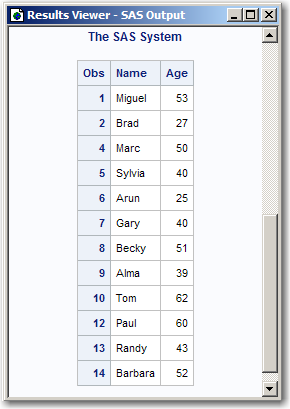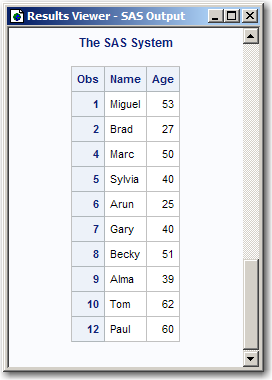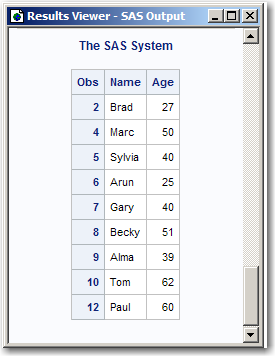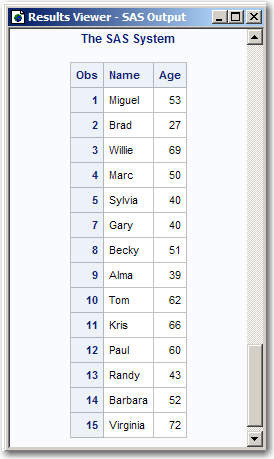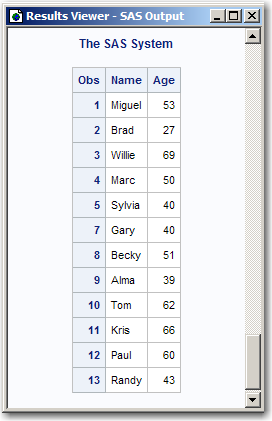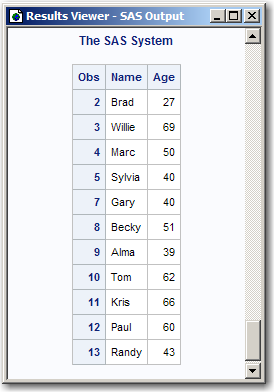OBS= System Option
Specifies the observation that is used to determine
the last observation to process, or specifies the last record to process.
| Valid in: | Configuration file, SAS invocation, OPTIONS statement, SAS System Options window |
| Category: | Files: SAS Files |
| PROC OPTIONS GROUP= | SASFILES |
| Interaction: | When you specify the OBS= option and EXTENDOBSCOUNTER=YES is set either as a data set option or as a LIBNAME option, data sets that have 2G–1 observations or more might perform better in a 32-bit environment. For more information, see Extending the Observation Count in a SAS Data File in SAS Language Reference: Concepts. |
| Note: | This option can be restricted by a site administrator. For more information, see Restricted Options. |
| See: | OBS System Option: UNIX in SAS Companion for UNIX Environments OBS System Option: Windows in SAS Companion for Windows |
Syntax
Syntax Description
- n | nK | nM | nG | nT
-
specifies a number to indicate when to stop processing, with n being an integer. Using one of the letter notations results in multiplying the integer by a specific value. That is, specifying K (kilo) multiplies the integer by 1,024; M (mega) multiplies by 1,048,576; G (giga) multiplies by 1,073,741,824; or T (tera) multiplies by 1,099,511,627,776. For example, a value of
20specifies 20 observations or records, while a value of3mspecifies 3,145,728 observations or records.
- hexX
-
specifies a number to indicate when to stop processing as a hexadecimal value. You must specify the value beginning with a number (0–9), followed by an X. For example, the hexadecimal value F8 must be specified as
0F8xin order to specify the decimal equivalent of 248. The value2dxspecifies the decimal equivalent of 45.
- MIN
-
sets the number to 0 to indicate when to stop processing.Interaction:If OBS=0 and the NOREPLACE option is in effect, then SAS can still take certain actions because it actually executes each DATA and PROC step in the program, using no observations. For example, SAS executes procedures, such as CONTENTS and DATASETS, that process libraries or SAS data sets. External files are also opened and closed. Therefore, even if you specify OBS=0, when your program writes to an external file with a PUT statement, an end-of-file mark is written, and any existing data in the file is deleted.
Details
OBS= tells SAS when to stop processing observations
or records. To determine when to stop processing, SAS uses the value
for OBS= in a formula that includes the value for OBS= and the value
for FIRSTOBS=. The formula is
Examples
Example 1: Using OBS= to Specify When to Stop Processing Observations
This example illustrates
the result of using OBS= to tell SAS when to stop processing observations.
This example creates a SAS data set, executes the OPTIONS statement
by specifying FIRSTOBS=2 and OBS=12, and executes the PRINT procedure.
The result is 11 observations, that is,
(12 - 2) +
1 = 11. The result of OBS= in this situation appears
to be the observation number that SAS processes last, because the
output starts with observation 2, and ends with observation 12, but
this result is only a coincidence.
Example 2: Using OBS= with WHERE Processing
This example illustrates
the result of using OBS= along with WHERE processing. The example
uses the data set that was created in Example 1, which contains 15
observations, and the example assumes a new SAS session with the defaults
FIRSTOBS=1 and OBS=MAX.
First, here is the PRINT
procedure with a WHERE statement. The subset of the data results in
12 observations:
Executing the OPTIONS
statement with OBS=10 and the PRINT procedure with the WHERE statement
results in 10 observations, that is,
(10 - 1) + 1 =
10. Note that with WHERE processing, SAS first subsets
the data and then SAS applies OBS= to the subset.
The result of OBS= appears
to be how many observations to process, because the output consists
of 10 observations, ending with the observation number 12. However,
the result is only a coincidence. If you apply FIRSTOBS=2 and OBS=10
to the subset, the result is nine observations, that is,
(10 - 2) + 1 = 9. OBS= in this situation is neither
the observation number to end with nor how many observations to process;
the value is used in the formula to determine when to stop processing.
Example 3: Using OBS= When Observations Are Deleted
This example
illustrates the result of using OBS= for a data set that has deleted
observations. The example uses the data set that was created in Example
1, with observation 6 deleted. The example also assumes a new SAS
session with the defaults FIRSTOBS=1 and OBS=MAX.
Executing the OPTIONS
statement with OBS=12, then the PRINT procedure, results in 12 observations,
that is,
(12 - 1) + 1 = 12: options obs=12; proc print data=Ages; run;
The result of OBS= appears
to be how many observations to process, because the output consists
of 12 observations, ending with the observation number 13. However,
if you apply FIRSTOBS=2 and OBS=12, the result is 11 observations,
that is
(12 - 2) + 1 = 11. OBS= in
this situation is neither the observation number to end with nor how
many observations to process; the value is used in the formula to
determine when to stop processing.
See Also
Data Set Options:
FIRSTOBS= Data Set Option in SAS Data Set Options: Reference
OBS= Data Set Option in SAS Data Set Options: Reference
REPLACE= Data Set Option in SAS Data Set Options: Reference
System Options:

